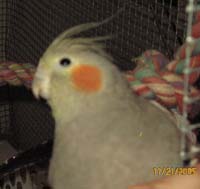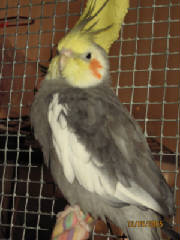|
Cockatiels HTML
Cockatiels are easily one of my favorite types of bird! They’re easy going, easy to breed, friendly, aren’t prone
to many behavioral problems other parrot species are known for and they won’t break your bank account if you want to
purchase one. They’re long lived, small enough to fit in even the smallest apartments and
many learn to speak. Males are most likely to talk, though I’ve met many females who eagerly hold conversations with
their slaves! They’re almost perfect!
Almost? Well, they are persistant noise makers, though the females aren’t as bad as the males. They’re not loud,
as in ‘rattle the windows’ loud. In in apartment building, most people won’t notice the noise. However, cockatiels
like to chatter and whistle almost constantly during the day and to some, it can be incredibly annoying. Your neighbors won’t
complain, but it might drive you nuts. Usually keeping the cage covered at night and not rewarding the persistant
calls with drama keeps the noise down to something reasonable. Females are usually quieter than the males, but this is only
a general guideline.
Cockatiels also produce a lot of feather dust. Most parrots have down feathers that shed about twice a year. Cockatiels don’t
shed these feathers. They break down into a dust, which helps with waterproofing their feathers and helps keep them in condition.
If you have allergies, this dust can be a problem but can be controlled by keeping the birds out of the bedroom, dusting regularly
and keeping an air purifier in the bird’s room. I have 3 cockatiels at the momment and the air purifier makes life MUCH
easier!
Handfeeding Instructions
Questions and Answers (under construction - if you have any questions, please email me with them!)
 |
|
Cockatiel Breeding Faq
At a Glance
Tiel Breeding Bio
Bio Facts:
# of eggs : 2-8
Length of incubation: 19-23 days
Fledging: about 3 weeks
Weaning: about 2 months
Adult at: 8-10 months
Recomended breeding age: 12-24 months
Ease of Breeding: 10 out of 10 . They can be TOO easy to breed!
Potential Problems: Egg binding and chronic egg laying!
Notes: Males and females both incubate the eggs. Both then feed the chicks when the eggs hatch. In the wild the birds
will use a hole in a tree as a nest. In captivity, they use a nest box about 12 x 9 inches. Calcium is super important when
these guys breed because hens tend to produce a lot of eggs and can easily deplete their calcium reserves.
Personal Notes:
My first Tiels: I bought three in February 2001.
First started breeding: I started breeding cockatiels the fall of 2001
|
 |


